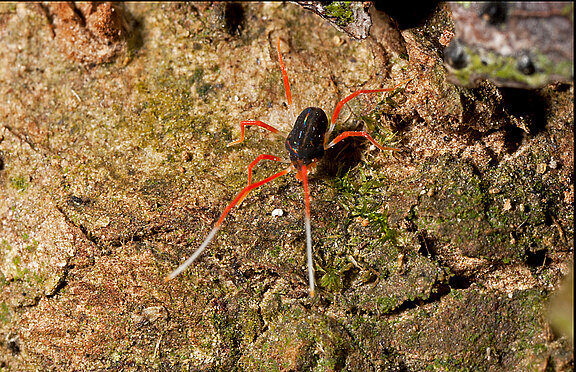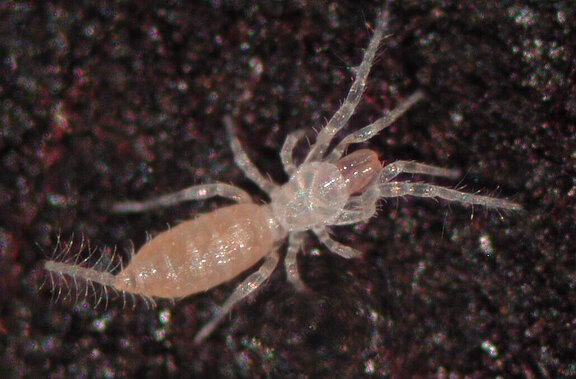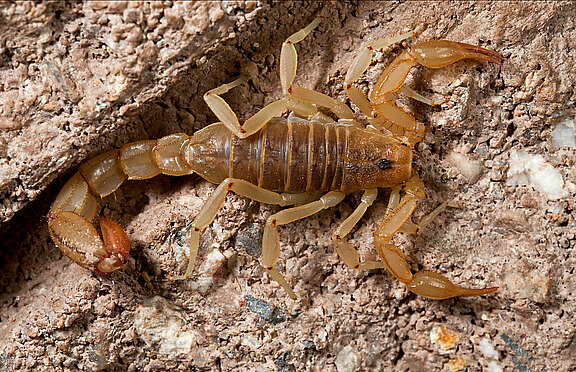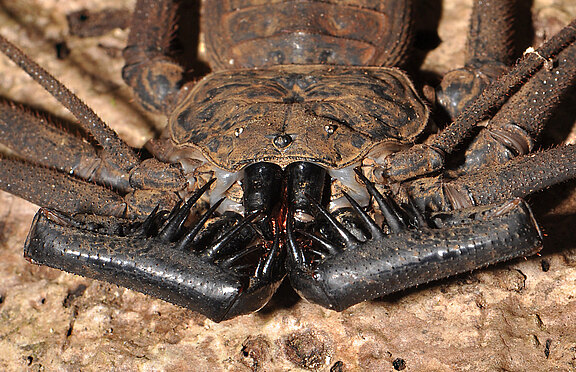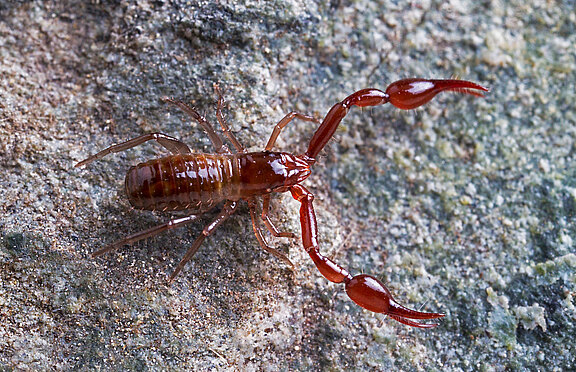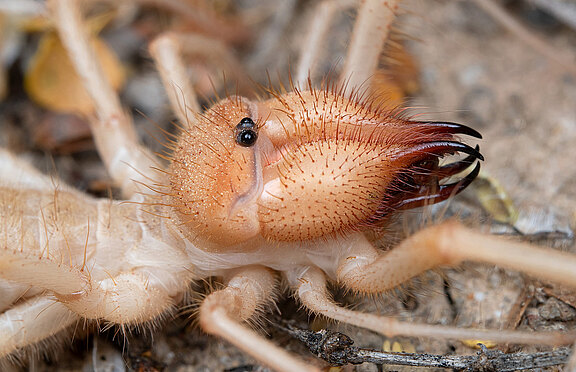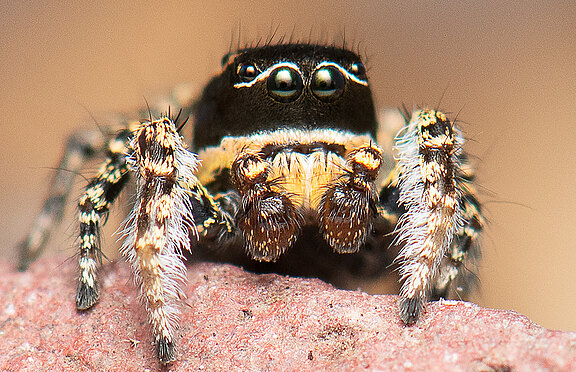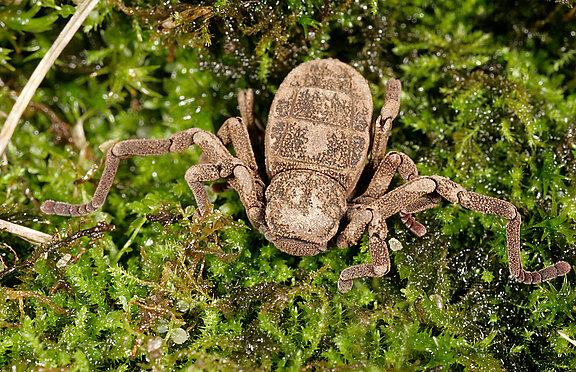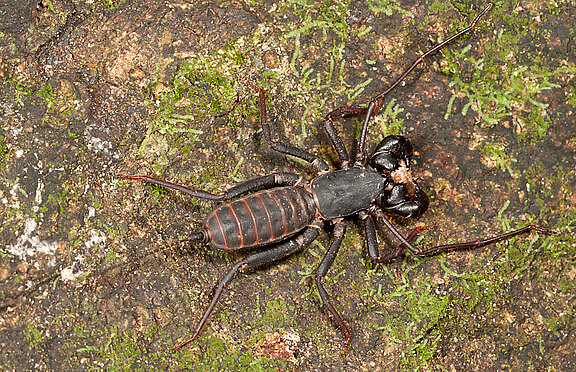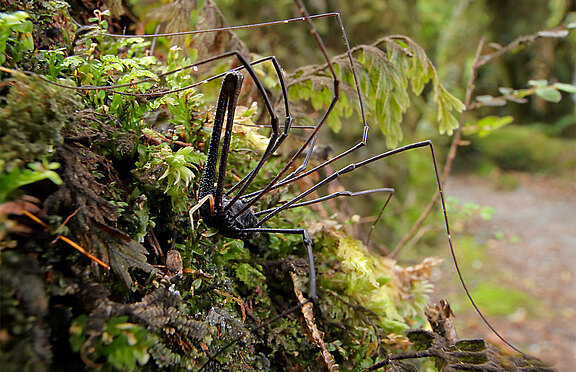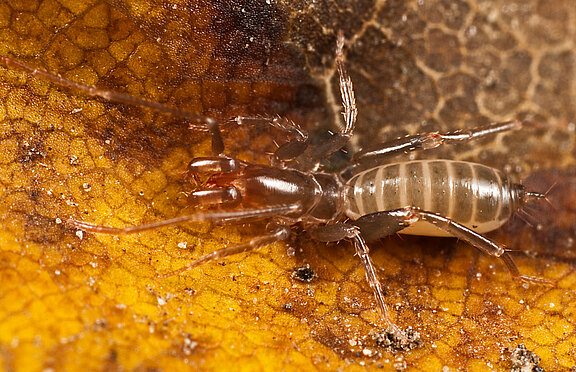List of all articles
Volume 51 Number 3
Phidippus regius, Salticidae, spider, red light, visible spectrum
Abstract
Jumping spiders (Araneae: Salticidae) possess a visual system that is exceptional among arthropods, mainly due to its unmatched acuity. Although vision of these spiders has been studied for decades, some of its main aspects remain unclear. One such aspect is the light spectrum visible to salticids, which is surprisingly heterogenous and involves various underlying physiological mechanisms. The results of the behavioral experiments with the regal jumping spider (Phidippus regius) presented in this study provide evidence that these vision-dependent spiders are able to capture their prey even under red (longwave) light, which is usually not perceived by spiders. Broader use of this experimental design in studies of spider vision is discussed.
Volume 51 Number 3
Scorpiones, fossil, Emsian, Scotland, sensory organ, pectines
Abstract
A cuticle fragment found in an Early Devonian (Emsian) macerate from the Strathpeffer–Struie outlier in the Northern Highlands of Scotland represents the isolated pectinal tooth of a scorpion. This remarkable find includes a distinctive field of small projections in rounded sockets consistent with the peg sensilla of extant scorpions. This is the oldest evidence for the presence of these characteristic sensory organs, which in modern scorpions play an important role in chemo- and mechanoreception. The fossil indicates that some scorpions had developed anatomically modern pectinal teeth at least 395 million years ago, suggesting that the pectines of these early scorpions played a similar role, physiologically and behaviorally, to those of living species.
Volume 51 Number 3
spider, type specimens, Andes, South America, diversity
Abstract
Eleven new species from the Scytodoidea group are described from mainland Ecuador: in the family Drymusidae, Drymusa pristirana sp. nov. (female) and in the family Scytodidae, Scytodes amazonica sp. nov. (male, female); S. argelia sp. nov. (female), S. ayampe sp. nov. (female), S. choco sp. nov. (male, female), S. costa sp. nov. (female), S. jaguar sp. nov. (male), S. loja sp. nov. (female), S. minus sp. nov. (male); S. orellana sp. nov. (male, female); and S. tayos sp. nov. (male). The new species D. pristirana sp. nov. presents a unique morphological character on the ventral surface of the female abdomen. The type specimens of S. lineatipes Taczanowski, 1874 from French Guiana and S. luteola Simon, 1893 from Venezuela are imaged for the first time, and S. romitii Caporiacco, 1947 is removed from synonymy with S. lineatipes.
Volume 51 Number 3
Avicularioidea, biogeography, Nemesiidae, Nemesioidina, taxonomy
Abstract
The open-holed trapdoor spiders of the Teyl damsonoides-group (formerly included in the now synonymized genus Merredinia Main, 1983) are revised, and 20 new species are described from the biodiversity hotspot of south-western Western Australia. The only previously described species, T. damsonoides (Main, 1983), is further re-described and re-illustrated, and molecular data from seven genes for a subset of nine species are analyzed using Bayesian methods. The damsonoides-group of Teyl are unusual for their stunning bi-colored appearance and the bowed morphology of the male metatarsus I, and we here document the known diversity and biology of these little-known spiders.
Volume 51 Number 2
BugGuide, community scientist, harvester, harvestmen, iNaturalist
Abstract
Community science has contributed significantly to biodiversity and conservation related research. iNaturalist is a popular community science application, where community-submitted photo documentation of observed taxa has led to a large natural history database. Here, we present results of an iNaturalist project focusing on documenting Opiliones introduced to the USA and Canada. Including all observations made in this project up through 31 December 2021, there were 849 total observations (486 research grade), which included 16 introduced species (excluding multiple species of uncertain status), 11 of which were newly recorded for the USA and Canada. We provide an updated checklist of introduced species, including updated distributions for previously recorded species. This research was facilitated by the community science platform iNaturalist, which allows easy interactions between scientists of all types.
Volume 51 Number 2
Temporal variation, strategic signaling, pheromone quantification, gas chromatography-mass spectrometry
Abstract
Female chemical signals are crucial for sexual communication in spiders and convey detailed information about females' mating status or age. However, evidence for chemical communication in spiders is largely behavioral. Only a few spider pheromones are known and quantitative chemical analyses of individual spiders are especially scarce. In the European wasp spider, Argiope bruennichi (Scopoli, 1772), females emit the volatile trimethyl methylcitrate, which attracts males from a distance. A recent study on the role of this pheromone in close-range male mate choice revealed that older virgin females approaching oviposition produce higher amounts of pheromone than younger ones, thereby increasing their attractiveness to males, and stop pheromone signaling shortly after copulation. Here we provide more detailed analyses of temporal dynamics in pheromone production in both virgin and mated female A. bruennichi. Our results corroborate previous observations indicating that male mating behavior in this species is guided by variation in female signaling effort.
Volume 51 Number 2
French Guiana, pitfall trap, phototaxis, diameter effect.
Abstract
Patterns of phototaxis are incompletely characterized in arachnids and hardly generalizable because of large variations in orders, families, species, environments, and methods employed. In a neotropical forest of French Guiana, we tested the effect of both light and diameter on pitfall trap catches. Light had a significant effect on capture rates of all arachnids and on Araneae alone, with more individuals caught in lit traps. Without light, pitfall diameter had no effect on capture rates, while in lit traps, significantly fewer individuals were captured only in smaller traps. Light trapping is thus a promising tool to complete inventories in tropical forests. This field experiment calls for further studies of the mechanisms by which arachnids are attracted by light, especially by unraveling an actual phototaxis from indirect effects like prey attraction.
Volume 51 Number 2
Survival, specialist, diet, fitness, ontogenesis
Abstract
Specialists possess specialized trophic adaptations. Spiders of the genus Palpimanus Dufour, 1820 are araneophagous spiders which also catch alternative prey. They have morphological, behavioral, and venomic adaptations tuned to higher efficacy in the capture and processing of other spiders. Here, we tested the hypothesis whether Palpimanus can develop on two prey types. We reared spiderlings of Palpimanus spp. on a diet composed of spiders and of insects, and recorded their performance. We found that Palpimanus exhibited significantly higher mortality on the insect diet. In fact, only spiderlings on the spider diet were able to develop. The developmental rate was slow, as one instar lasted on average more than 60 days. On the basis of this finding, we estimated that the life cycle is at least biennial. We conclude that Palpimanus spiders possess specialized prey-capture adaptations towards spider prey which prevent them to utilize alternative prey.
Volume 51 Number 2
Arachnida, hydric stress, ecophysiology, water deficit
Abstract
Water conservation is one of the major challenges encountered by terrestrial arthropods; species inhabiting dry forests are hypothesized to have adapted to dry conditions. Tityus pusillus Pocock,1893 is one of the most abundant scorpion species in northeastern Brazil, occurring in dry and tropical rainforests. Considering the wide distribution of T. pusillus, we aimed to investigate differences in desiccation resistance between populations originating from the Atlantic rainforest and the Caatinga dry forest. In this study, 40 individuals of T. pusillus from each of the two ecosystems were used. The two groups were separated into control and treatment groups (individuals without a water supply). Scorpions from the Atlantic rainforest had a shorter lifespan than those from the Caatinga dry forest, both in the control and treatment groups. However, the weight loss rate was higher in scorpions from the Caatinga dry forest than those from the Atlantic rainforest. In addition, Atlantic rainforest scorpions presented a lower resistance to desiccation, exhibiting a higher mortality rate than the Caatinga dry forest individuals. These results suggest that T. pusillus can exhibit, via phenotypic plasticity or local adaptation, a broad range of tolerances that allow it to persist in different habitats. Furthermore, our findings suggest that T. pusillus individuals from the Caatinga dry forest have physiological attributes that allow them to resist prolonged desiccation, which may be related to adaptations that are intrinsic to the population from the dry forest.
Volume 51 Number 2
Allometric growth, Italy, nymphal instars, sexual dimorphism, trichobothria
Abstract
Pseudoscorpions are arachnids featuring three nymphal instars before reaching the adult age. Instars can be mostly recognized based on the number of trichobothria which lie along the chelal axis: as the individual grows, further trichobothria are added. The study of the post-embryonic growth based on trichobothria position has been the most widely used approach. However, other body parts can be subjected to particular growth patterns that need to be explored to fully understand post-embryonic development processes. Rigorous numerical approaches that allow meaningful statistical inference within growth regressions are now available. The recently described Mediterranean species Geogarypus italicus Gardini, Galli & Zinni, 2017 gave the authors the chance to review studies carried out in the past with the modern statistical approach mentioned above. Results confirm the main hypothesis about the growth process of the chelal axis but showed some differences that may be related to taxonomical aspects. Moreover, the study of body allometry during postembryonic growth showed that not all body parts undergo the same trend from protonymphs to males, on one side, and to females, on the other. Finally, the study of proportions between body parts through the analysis of ratios between their linear measurements pointed out a marked sexual dimorphism of pedipalps in spite of similar sizes and proportions of other body regions. The analysis led us to think that more interesting information could come from applying this approach to multispecies studies.
Volume 51 Number 2
Multimodal communication, sexual selection, chemical ecology, predator-prey interaction, sensory ecology.
Abstract
The largest family of spiders, jumping spiders (Salticidae), is known for performing complex visually mediated predatory and courtship behavior. As cursorial predators, they rely on their sensory systems to identify objects at a distance. Based on these assessments, salticids perform flexible and target-specific behavioral sequences which demonstrate a high level of cognitive processing. Recent studies have highlighted the role of other sensory modalities in these processes, such as chemoreception and mechanoreception, and elucidated the visual cues used for object identification, including motion, color, contrast, and shape-based cues. Until recently, sensory modalities other than vision were largely overlooked, but current advances in technology now allow us to probe their sensory and cognitive capabilities, as well as how these are shaped by experience. In this review, I provide an overview of current knowledge of salticid behavior and the sensory systems underpinning this behavior, and highlight areas in need of further research. This review focusses on our understanding of salticid communication, parental behavior, personality, antipredator behavior, and diet, as well as habitat selection. I argue that a historical vision-based focus on a small number of species due to their coloration or their unusual behavior provides a springboard for a deeper understanding of the general cognitive and sensory attributes that have evolved in this lineage, of which we yet have much to learn.
Volume 51 Number 2
pseudoscorpion, taxonomy, identification key, China.
Abstract
Twenty new species of the genus Bisetocreagris Ćurčić, 1983 are described from caves in the provinces of Guizhou (B. baiyunensis sp. nov., B. baimensis sp. nov., B. bangenensis sp. nov., B. daxingensis sp. nov., B. diaojiangensis sp. nov., B. dongjiensis sp. nov., B. duolangpingensis sp. nov., B. ganxiaoensis sp. nov., B. guanyinensis sp. nov., B. matuoensis sp. nov., B. sanhensis sp. nov., B. shahensis sp. nov., B. shangshanensis sp. nov. and B. yaolinensis sp. nov.), Yunnan (B. mahnerti sp. nov. and B. tuanjiensis sp. nov.), Sichuan (B. tianyangensis sp. nov.), Chongqing (B. xianduhensis sp. nov.), Hubei (B. changchaoensis sp. nov.) and Guangxi (B. xiniuyanensis sp. nov.). An identification key is provided to all known Chinese cave-inhabiting representatives of the genus Bisetocreagris.
Volume 51 Number 2
Non-native species, introduced species, invasive arthropods, citizen science, geographic distribution, range expansion
Abstract
Introductions of non-native species to novel environments happen often, but a species must overcome multiple biotic and abiotic filters to establish and eventually spread. Focusing on patterns of introductions can provide insights as to underlying mechanisms that facilitate establishment, and in turn, their potential effects on native communities. The brown widow spider, Latrodectus geometricus C. L. Koch, 1841, is likely native to Africa, but now has a cosmopolitan distribution due to introductions via international trade. We reviewed the patterns of brown widow introductions in the Americas to determine if there are any large-scale inferences regarding their patterns, and potential impacts, of their introduction. A total of 5,004 records from 30 countries were synthesized and demonstrate their spread to higher latitudes across time with the majority of those records (n = 4,923; 98%) occurring in the past two decades. Brown widows are now documented in 30 of the 35 countries in North, Central, and South America, with one-third of those introductions detected in the last 30 years. Citizen-science databases (e.g., iNaturalist) have been instrumental in documenting the expansion of the brown widow, as more than 90% of the records synthesized came from these sources. Brown widows have proven to be successful invaders worldwide, and this review synthesizes expansion reports of their invasion in the Americas in hopes of spurring additional research in locations where they have become established.
Volume 51 Number 2
courtship behavior; mound-building; Greater Mountains
Abstract
In this study, I provide the first description of mating behavior in the field for the genus Castianeira Keyserling, 1879 (Araneae: Corinnidae). Females have been observed building intricate mounds over their egg sacs; this study describes mating behavior while the female was building a mound—suggesting that females may have more than one clutch of offspring during the mating season or that she may store sperm for the next mating season. Analysis of my field footage and observational data revealed a simple mating behavior with little pre-or post-copulatory interaction. I compared my observations with laboratory observations by Montgomery (1909) of Castianeira descripta (Hentz, 1847) and Castianeira longipalpa (Hentz, 1847). The mating behaviors are similar in length but the sequence and duration of coupling differed. These observations create a starting point for better researching courtship and mating behavior of this spider, the number of egg sacs produced during a season, as well as the role of mound-making in the reproduction process.
Volume 51 Number 2
Cave-dwelling spiders, conservation, niche segregation, subterranean habitats, lava caves
Abstract
Meta menardi (Latreille, 1804) and M. bourneti Simon, 1922 (Araneae: Tetragnathidae) are ubiquitous inhabitants of the twilight zone of most hypogean sites across Europe. Recent observations in volcanic caves pointed out the presence of both species in Sicily, with M. menardi occurring in a small number of caves. On the basis of field investigations conducted in 2017–2021, we analyzed the distribution and the habitat frequency of the two species along the altitudinal gradient of Mount Etna. Our results demonstrate a significant effect of climate and altitude on the segregation of the two species, with M. menardi occurring exclusively above 1200 meters in caves opening in areas characterized by low temperatures (mean ± SD = 10.1 ± 0.688C) and high precipitations (682 ± 19 mm). Conversely, M. bourneti preferably occurred in areas with higher temperatures (14.5 ± 2.18C) and lower precipitations (606 ± 46 mm). Substrate age was not affecting the distribution of the two species, as both occurred in volcanic caves of ancient and recent formation (from 350 to .1,000 years). In light of the ongoing global warming, a possible increase in temperature could favor the upshift of M. menardi towards upper areas on the volcano subjected to high volcanic disturbance and thus unsuitable for hosting stable populations through time. In this regard, investigations on the response of Meta spiders to increases in temperature on the Etna volcano would be an asset to establish an appropriate management plan for the conservation of the newly discovered population of M. menardi in Sicily.
Volume 51 Number 2
Body size, orb web construction, measurement techniques, Araneidae
Abstract
Spider webs, and in particular orb webs, are among the most iconic characteristics of spider biology. The evolution of, and developmental changes in, orb webs have been well studied, but we still have a limited understanding of allometric relations between the size of orb webs and spider body size. In this study, we investigate this relationship using measurements from 55 individuals of two common orb-weaving spider (Araneidae) species in South Wales, UK. We recorded body size using two methods: direct measurements with calipers, and estimations from photographs using ImageJ software. We found that these two methods give almost identical measurements, supporting the use of image-based size measurement in many situations where this is advantageous. We also found evidence for negative allometry of orb web size (relative to spider body length), such that larger spiders build proportionately smaller webs. This implies that the ‘giant webs’ in some orb-weaver species must be the result of a fundamental shift in the constraints or advantages which result in the allometric relationships described here.
Volume 51 Number 2
Whip-scorpion, biodiversity, new taxa
Abstract
The giant vinegaroons of the genus Mastigoproctus Pocock, 1894 have been the subject of recent investigations aimed at elucidating relationships between their species and their validity. In particular, new data have revealed the presence of new species as well as revalidated species that were previously considered as synonyms of Mastigoproctus giganteus (Lucas, 1835). The genus occurs in southern USA, Mexico and South America. In this paper, we describe three additional new species from Mexico: M. franckei Barrales-Alcalá, sp. nov. from Xilitla, San Luis Potosí, M. xetame Barrales-Alcalá & Francke, sp. nov. from the highlands of Jalisco and M. yalchanchak Barrales-Alcalá & Francke, sp. nov. from La Esperanza, Chiapas. The present contribution raises the diversity of the order Thelyphonida in Mexico to 10 species.
Los vinagrillos del género Mastigoproctus Pocock, 1894 han sido objeto de investigaciones recientes encaminadas a dilucidar las relaciones entre sus especies y la validez de las mismas. En particular, nuevos datos han revelado la presencia de nuevas especies, así como la validez de otras que antes se consideraban como sinónimos de Mastigoproctus giganteus (Lucas, 1835). El género se encuentra en el sur de Estados Unidos, México y Sudamérica. En este artículo, describimos tres nuevas especies adicionales de México: M. franckei Barrales-Alcalá, sp. nov. de Xilitla, San Luis Potosí, M. xetame Barrales-Alcalá & Francke, sp. nov. del altiplano de Jalisco y M. yalchanchak Barrales-Alcalá & Francke, sp. nov. de La Esperanza, Chiapas. La presente contribución eleva la diversidad del orden Thelyphonida en México a 10 especies.
Volume 51 Number 2
Mygalomorphae, East Asia, biogeographic hypothesis, dispersal, marine intertidal
Abstract
Most spiders are exclusively terrestrial with only some groups venturing into aquatic habitats, and only a handful of representatives colonizing the marine intertidal zone. Here, we describe a new intertidal trapdoor spider species, Idioctis parilarilao sp. nov., from southern Taiwan and Green Island (Lutao). The original DNA barcode enables species delimitation between different populations from Taiwan and the morphologically closest species, Idioctis xmas, from Christmas Island, Indian Ocean. These analyses reveal that all populations from Taiwan, including Green Island, are conspecific, and are distinct from Idioctis xmas. Given the lack of representation of other species in public databases, our COI gene tree should be seen as preliminary, but it does support the monophyly of the genus Idioctis. As the genus was not previously known from East Asia, our discovery vastly extends the distribution range of Idioctis and the family Barychelidae. Given the tectonic and volcanic specifics of the history of Taiwan and Green Island, and the direction of the known oceanic currents, we provide a preliminary explanation of the biogeographic and diversification history of intertidal spiders in the region.
Volume 51 Number 1
Aril, caloric value, diet, elaiosome, fruit waste, fungal spores, mushrooms, seeds.
Abstract
In this review, we report on harvestmen and spiders feeding on fungi, fruits, and seeds. Fungivory in harvestmen is widespread, with most reports referring to tropical species in the family Sclerosomatidae, which consume mainly small forest mushrooms (families Marasmiaceae and Mycenaceae). In contrast, consumption of fungal material by spiders apparently occurs only if airborne spores trapped in the viscid threads of orb-webs (e.g., Araneidae and Tetragnathidae) are ingested along with old webs prior to the construction of new webs. Consumption of fruit pulp by harvestmen is also widespread, with several records of Leiobunum spp. (Sclerosomatidae) feeding on Rubus spp. berries and other lipid-poor fruits in the Holarctic region. In Neotropical forests, harvestmen in the families Cosmetidae and Gonyleptidae feed on lipid-poor pulp of fallen fruits. Among spiders, we document several cases of synanthropic species opportunistically feeding on fruit waste (e.g., pieces of banana, papaya, watermelon, or orange pulp) inside houses or disposed in yards. Only one case of a spider feeding on a wild fruit in the field was found in our search. Finally, we report several cases of harvestmen and spiders feeding on elaiosomes or arils (i.e., lipid-rich seed appendages). In conclusion, harvestmen consume mushrooms, fruit pulp, seeds, and seed appendages more frequently than spiders probably because they are “solid food feeders”, which means they can ingest solid tissues by biting off small pieces. In turn, spiders are “fluid feeders” and feed on vegetable matter most frequently in the form of fluids (e.g., nectar, stigmatic exudate, plant sap, and honey dew), rather than fungal or plant tissues.
Volume 51 Number 1
Araneae abundance, richness, tree-shrub strata, composition, seasonal variation
Abstract
Spiders are usually found through all seasons in the subtropics, but little is known about their seasonality patterns and how they respond to abiotic factors, especially in species-rich regions such as Brazil. We investigated the seasonal variation in spider communities and the possible influence of abiotic factors (e.g., temperature, rainfall) on spider abundance, species richness and composition in subtropical riparian forest in four river basins. Changes in spider abundance among seasons differed between ontogenetic stages: there were more spiderlings in the autumn, and similar numbers of adults year round. Species richness, on the other hand, was highest in spring and summer. Species composition differed between seasons and river basins. Several factors may be behind diversity changes in the araneofauna among seasons, however, none of the abiotic factors evaluated showed a strong direct influence. Seasonal patterns varied, with different species having peaks in all three seasons but autumn. Seasonality is clear in these spider communities but not all patterns follow predictions from simple temperature changes.
Volume 51 Number 1
Abstract
A new species of giant trapdoor spider, Euoplos dignitas sp. nov. (family Idiopidae), is described from the Brigalow Belt of inland Queensland, Australia. Phylogenetic analysis of a six gene molecular dataset for the tribe Euoplini reveals that this species is sister to the spinnipes-group from eastern Queensland, and unrelated to a morphologically similar congener (E. grandis Wilson & Rix, 2019) that occurs further south in the Brigalow Belt. Both E. dignitas sp. nov. and E. grandis are very large, scopulate, plug door-building trapdoor spiders from transitional woodland habitats on vertosols (‘black soils’), with superficially similar females and strongly sexually-dimorphic ‘honey-red’ males. Information on the known biology and distribution of E. dignitas sp. nov. is summarized, and a conservation assessment is provided under the International Union for Conservation of Nature’s (IUCN) Red List Criteria, indicating that this species is likely Endangered.
Volume 51 Number 1
Harvestmen, Laniatores, Neotropics, Central America, rutrum, mons cribellatus.
Abstract
A new genus and species of Neotropical Grassatores, Hevelia crucis gen. et sp. nov., is described and illustrated based on material of both sexes from Colombia. After comparison with the greater groups in Zalmoxoidea, especially the putative early derivative families Guasiniidae and Icaleptidae, this new taxon is considered a Zalmoxoidea incertae sedis, and seems to be related with Trypophobica Cruz-López et al., 2021 (currently in Icaleptidae, but which should be removed from this family) and Costabrimma Goodnight & Goodnight, 1983 (currently in Zalmoxoidea incertae sedis), both from Central America. Two species currently included in the zalmoxid genus Stygnoleptes Banks, 1913 from El Salvador are transferred to Trypophobica, creating the new combinations T. gibbera (Roewer, 1954) and T. sellata (Roewer, 1954). Two morphological structures for Zalmoxoidea are named here: mons cribellatus (sexually dimorphic porous prosomal and/or abdominal dorsal hillock) and elbow-spade (lanceolate blade apical in the truncus penis).
Volume 51 Number 1
CTMin, CTMax Latrodectus, development, invasive species
Abstract
Temperature strongly shapes the physiology and distributions of ectotherms. Environmental extremes and the range of temperatures encountered can limit persistence. Further, thermal tolerance limits are thought to be one of the factors limiting the distributions of invasive species. The critical thermal maximum (CTMax) and critical thermal minimum (CTMin) are metrics frequently applied for defining upper and lower thermal tolerances, respectively. Temperatures contained within the boundaries of the CTMax and CTMin comprise the thermal tolerance range. In this study, we tested whether thermal tolerances differed between two native (Latrodectus hesperus Chamberlin & Ivie, 1935 and L. mactans (Fabricius, 1775)) and one invasive (L. geometricus CL Koch, 1841) widow species (Latrodectus Walckenaer, 1805). We separately tested if thermal tolerances differed by life stage and sex. Using species distribution modelling, we also tested if thermal extremes or temperature range most accurately correspond with current species occurrences in the United States. We hypothesized that Latrodectus geometricus would have lower thermal tolerance range and that minimum temperatures would most influence their present distributions since they presumably originated from a more equatorial climate. We found that CTMin did not vary by developmental stage, but was highest in males. We found that the CTMin and CTMax of L. geometricus (3.2, 51.5 °C) and L. mactans (1.9, 52.4 °C) were higher than L. hesperus (-1.9, 49.6 °C). Males also had the narrowest thermal tolerance range in the three species examined. Lastly, we found that the highest performing distribution model was the one correlating minimum temperature with L. geometricus occurrences.

